Leif Ove Andsnes directing two great Mozart piano concertos from the keyboard may be the chief attraction when the Norwegian Chamber Orchestra comes to London's Cadogan Hall on Friday to celebrate its 40th birthday. It was certainly the bait which lured me to Oslo last week. But in talking to the Renaissance man who has led the ensemble since its foundation in 1977, Terje Tønnesen, I discovered that what I heard – including a Haydn symphony just as revelatory as the Mozart concertos – was just the tip of the creative iceberg. Londoners will get a greater slice of that individuality when the NCO play Prokofiev's "Classical" Symphony and Grieg's Holberg Suite from memory.
I found out more from Tønnesen the morning after the concert. Which in itself was predictably excellent, but brought a surprise of a different kind. Having admired Edvard Munch's The Sun on the box cover of an LP set featuring Schoenberg's Gurrelieder, I'd wondered where it was housed. I had no idea it was the centrepiece, the high altar, as it were, of a mural series in Oslo's main temple of learning, the University Aula where the Norwegian Chamber Orchestra gives the majority of its concerts on home territory.
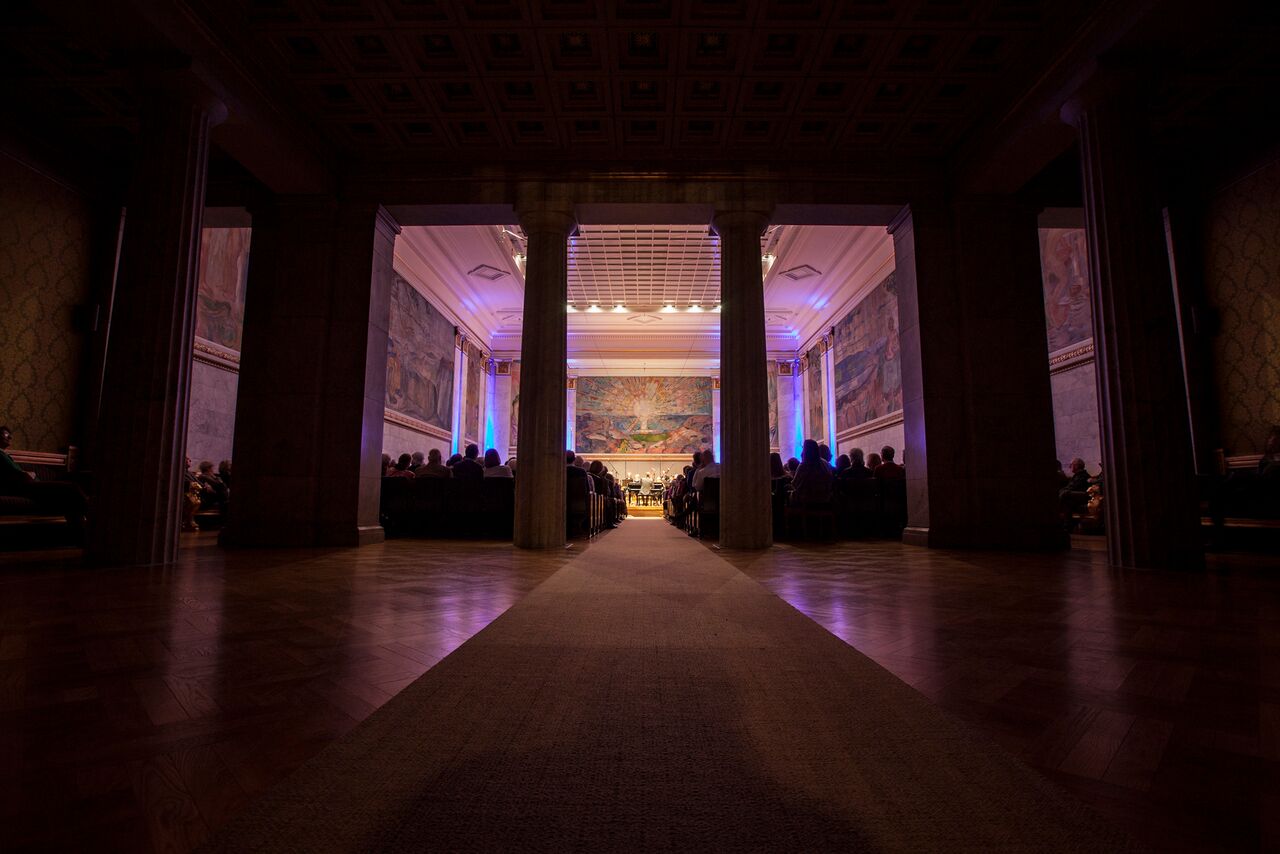 The sun glints in the distance as you approach through the vestibule (pictured above). Once entering the hall itself between the columns, two more large-scale scenes complement the al fresco idyll, clearly set on the Norwegian coast with its rocks and islets in midsummer: on the left, "History" is celebrated by an old man telling stories to a young boy, while "Alma Mater" on the right has a mother nourishing her children. Further panels celebrate naked youth in the sunshine. Predictably there was uproar among the academic worthies, and the unveiling didn't take place until 1916, seven years after Munch was announced the winner of the university competition to decorate the aula.
The sun glints in the distance as you approach through the vestibule (pictured above). Once entering the hall itself between the columns, two more large-scale scenes complement the al fresco idyll, clearly set on the Norwegian coast with its rocks and islets in midsummer: on the left, "History" is celebrated by an old man telling stories to a young boy, while "Alma Mater" on the right has a mother nourishing her children. Further panels celebrate naked youth in the sunshine. Predictably there was uproar among the academic worthies, and the unveiling didn't take place until 1916, seven years after Munch was announced the winner of the university competition to decorate the aula.
These are joyous scenes for Munch, unfairly labelled a miserabilist; at the time of painting them he had just emerged from confinement in a Copenhagen psychiatric clinic, positive and full of life. They couldn't help but inform the more joyous of the scores on last week's second Aula programme, chiefly Mozart's K482 E flat Piano Concerto, and Haydn's Symphony No. 95. The mystery of the most recent work on the programme, Norwegian composer Magnar Åm's 1977 tone-poem Study of a Psalm Melody from Luster, was also in tune with the great outdoors pictured above it.
Andsnes' relationship with the NCO goes back a long way. The ensemble's status as a self-styled "project orchestra" gathering together many of Norway's finest instrumentalists for intensive periods of work and touring has included invitations to serve as guest artistic leader to the likes of Steven Isserlis, Isabelle van Keulen and Anthony Marwood, and of course Andsnes, who over five seasons performed some of the greatest Mozart concertos, followed by the five Beethovens in the warm surroundings of the Norwegian National Opera, interpretations we know well from his visit to the Proms with the Mahler Chamber Orchestra.
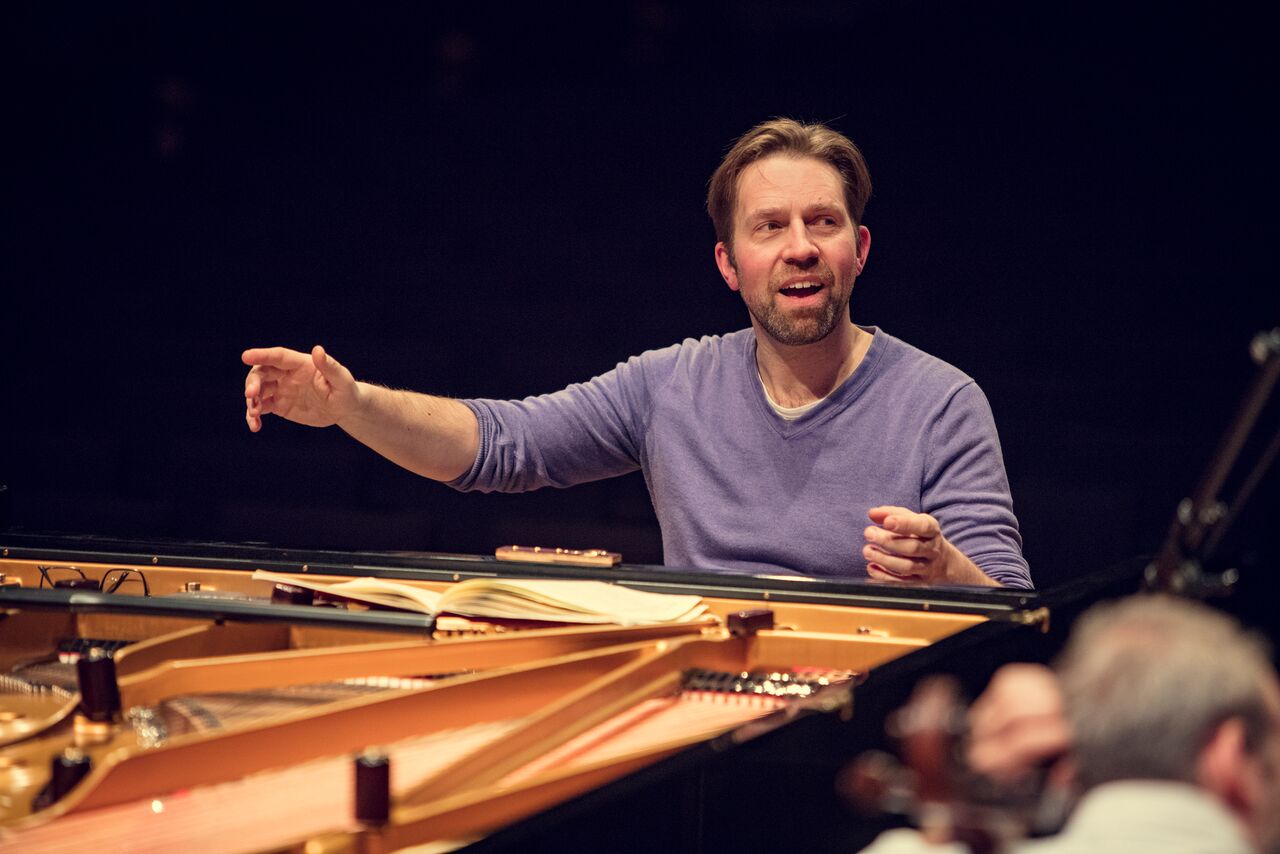 Now he's added two more to the Mozart list. As he told me over tea before the concert (rehearsal pictured above), “This is a completely different story for me. The D minor [K466] was the first concerto I played with a professional orchestra, in Stavanger when I was 14, and it's always been part of my life, so now it’s like coming back to an old friend. Whereas the E flat is completely new to me, I played it for the first time two weeks ago, and I'm so in love with it.” We talk about the extraordinary finale, its lively rondo coming to a halt to accommodate a heaven-sent, woodwind-led slow serenade of a minuet. “It's so operatic and so like a farewell towards the end. It must have been his own 'Jeunehomme' Concerto [No. 9], the earliest of the three E flat concertos, which inspired the pattern of that grand finale.”
Now he's added two more to the Mozart list. As he told me over tea before the concert (rehearsal pictured above), “This is a completely different story for me. The D minor [K466] was the first concerto I played with a professional orchestra, in Stavanger when I was 14, and it's always been part of my life, so now it’s like coming back to an old friend. Whereas the E flat is completely new to me, I played it for the first time two weeks ago, and I'm so in love with it.” We talk about the extraordinary finale, its lively rondo coming to a halt to accommodate a heaven-sent, woodwind-led slow serenade of a minuet. “It's so operatic and so like a farewell towards the end. It must have been his own 'Jeunehomme' Concerto [No. 9], the earliest of the three E flat concertos, which inspired the pattern of that grand finale.”
I wondered whether intense study of the Beethoven concertos had changed anything. “It’s difficult to say. Of course the D minor is quite Beethovenian, the one he admired the most, and loved very much. And I’m playing Beethoven’s cadenza in the first movement, Hummel’s in the finale. What I felt during those years with Beethoven was how important it is to express things really clearly, because the intention is so clear all the time, and of course in Mozart there is more ambiguity. In the first movement of the E flat concerto, for instance, when I started to study it, I realised it’s not clear what is foreground and what is background [he sings a legato line for the winds, and another for the violins] – it's just a web. It's very fascinating, you can choose what to emphasise, but both are actually equally important, and that's what is so great, that you have these voices. But it's still important to be understood, so maybe I bring with me some of that. Whether that has to do with Beethoven or whether I'm becoming more confident with this music as a whole, I don't know.”
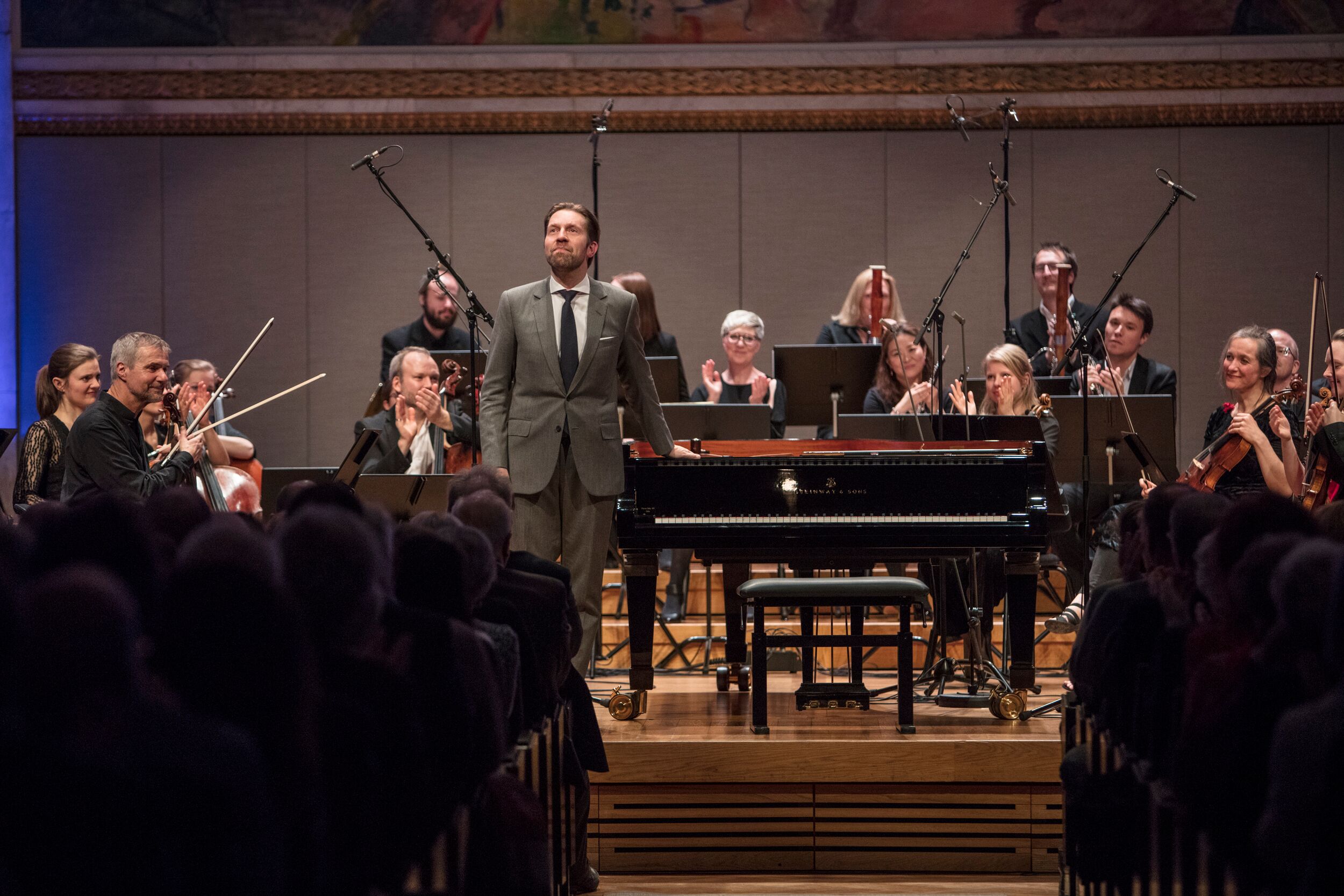 As both musician and as human being, Andsnes never does flash, never comes out with an insincere word. His pianism flowed out of the orchestral playing he conducted and back again, with that legendary evenness in fast runs, only dominating in the cadenzas. I'm not sure that the one in the first movement of the E flat major was entirely organic within itself – Andsnes hadn’t found a cadenza that suited him, and went along with the work of his EMI producer John Fraser, of which he’s very fond – but Beethoven's for the D minor was magnificent on its own terms. And in any case the orchestral playing, especially in the finale, was meatier, more Beethoven-like than you'd expect from a chamber orchestra playing Mozart. With, of course, wonderful work from the woodwind – exceptionally so from first oboist, Mizuho Yoshii, who somehow managed to make us forget that there weren't clarinets, the real stars of the concertos featuring them, in the D minor work.
As both musician and as human being, Andsnes never does flash, never comes out with an insincere word. His pianism flowed out of the orchestral playing he conducted and back again, with that legendary evenness in fast runs, only dominating in the cadenzas. I'm not sure that the one in the first movement of the E flat major was entirely organic within itself – Andsnes hadn’t found a cadenza that suited him, and went along with the work of his EMI producer John Fraser, of which he’s very fond – but Beethoven's for the D minor was magnificent on its own terms. And in any case the orchestral playing, especially in the finale, was meatier, more Beethoven-like than you'd expect from a chamber orchestra playing Mozart. With, of course, wonderful work from the woodwind – exceptionally so from first oboist, Mizuho Yoshii, who somehow managed to make us forget that there weren't clarinets, the real stars of the concertos featuring them, in the D minor work.
Never underestimate the difficulties and rewards of Haydn. Tønnesen told me the morning after how taken aback he'd been by the demands of Symphony No. 95, as quirky a work as any of its late counterparts – the subtle tempo changes, the pick-ups after dramatic pauses (which allowed the sound to resonate in the Aula acoustics: the orchestra's CEO, Per Erik Kise Larsen, thinks they're a little harder since the Munchs were remounted with boards behind them, but it's still a near-ideal venue for a chamber orchestra). At any rate, all the maneouvres were achieved with a decisiveness and a personality I learnt more about from Tønnesen in the NCO's new office space, part of a splendidly converted 19th century bank with Venetian affectations on the outside. The conversion, which houses many key arts organisations based in Oslo, has handsome rehearsal spaces, several rooms good enough to allow for chamber music and a ground-floor hall where the NCO can hold concerts more relaxed than in the teetotal Aula; there's a bar at the back.
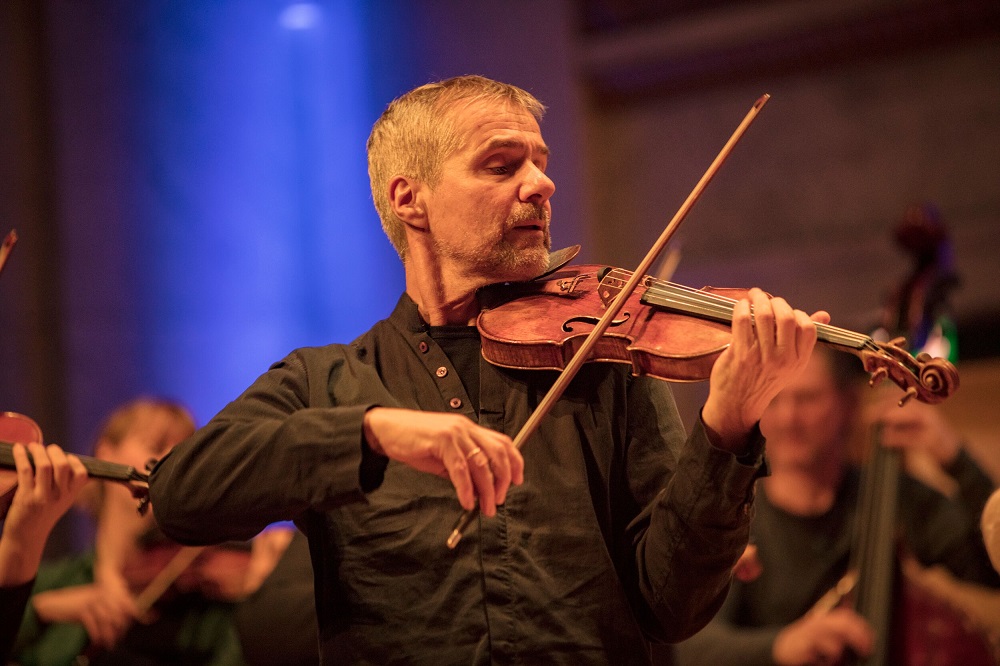 Tønnesen (pictured above) is clearly a questing soul. His first ambition was to be an artist; married to an actor, Hilde Grythe, he composes incidental music for plays and has also enlisted dramatic help in trying to get the players to break down what he calls “the fourth wall” between them and the audience. Dramatic readings, most recently from Tolstoy’s harrowing novella The Kreutzer Sonata to inform Tonnesen’s string transcription of the Janáček quartet based on the story of jealousy and murder, enhance the experience (a new CD set of both Janáček quartets and selections from the Tolstoy, in both Norwegian and English, has just been released).
Tønnesen (pictured above) is clearly a questing soul. His first ambition was to be an artist; married to an actor, Hilde Grythe, he composes incidental music for plays and has also enlisted dramatic help in trying to get the players to break down what he calls “the fourth wall” between them and the audience. Dramatic readings, most recently from Tolstoy’s harrowing novella The Kreutzer Sonata to inform Tonnesen’s string transcription of the Janáček quartet based on the story of jealousy and murder, enhance the experience (a new CD set of both Janáček quartets and selections from the Tolstoy, in both Norwegian and English, has just been released).
It’s all about communication. As concert-master of the Oslo Philharmonic, Tønnesen found himself frustrated by the low level of understanding which results from “three rehearsals and a performance”. That led to a crisis, not long after he’d founded the NCO, in which he seriously thought about giving up as a musician, only to be saved by a Swedish film, The Brothers Mozart, which spelled out to him the essence of creativity. There have been some ground-breaking projects with the NCO, chiefly “The Gates of Hell”, for which the players studied yoga and drama to emulate Rodin’s figures in the first half of the evening, the audience encouraged to walk around and study them, and played Strauss’s Metamorphosen in the second – from memory. If you can memorise that, and Schoenberg’s Verklärte Nacht, you can memorise anything.
Score-less performance is catching on over here: the Aurora Orchestra and Nicholas Collon have done it several times, with the greatest success at the Proms. It's not a gimmick, like colourful dress, cool lighting or letting the audience bring in drinks to encourage the young. Being able to communicate the inner meaning of the music both to your fellow-players and the audience is liberating. I witnessed the vivacious leadership of each of the string sections in the Oslo concert; but there, the score still ruled. In London, you get a chance in the Prokofiev and the Grieg to see what the memorisation principle means in practice. Don’t miss it.
Next page: the Norwegian Chamber Orchestra perform the Rigaudon from Grieg's Holberg Suite and Strauss's Metamorphosen without scores
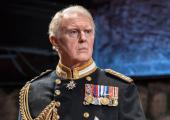





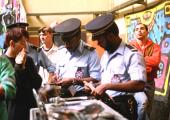
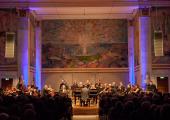
 The sun glints in the distance as you approach through the vestibule (pictured above). Once entering the hall itself between the columns, two more large-scale scenes complement the al fresco idyll, clearly set on the Norwegian coast with its rocks and islets in midsummer: on the left, "History" is celebrated by an old man telling stories to a young boy, while "Alma Mater" on the right has a mother nourishing her children. Further panels celebrate naked youth in the sunshine. Predictably there was uproar among the academic worthies, and the unveiling didn't take place until 1916, seven years after Munch was announced the winner of the university competition to decorate the aula.
The sun glints in the distance as you approach through the vestibule (pictured above). Once entering the hall itself between the columns, two more large-scale scenes complement the al fresco idyll, clearly set on the Norwegian coast with its rocks and islets in midsummer: on the left, "History" is celebrated by an old man telling stories to a young boy, while "Alma Mater" on the right has a mother nourishing her children. Further panels celebrate naked youth in the sunshine. Predictably there was uproar among the academic worthies, and the unveiling didn't take place until 1916, seven years after Munch was announced the winner of the university competition to decorate the aula. Now he's added two more to the Mozart list. As he told me over tea before the concert (rehearsal pictured above), “This is a completely different story for me. The D minor [K466] was the first concerto I played with a professional orchestra, in Stavanger when I was 14, and it's always been part of my life, so now it’s like coming back to an old friend. Whereas the E flat is completely new to me, I played it for the first time two weeks ago, and I'm so in love with it.” We talk about the extraordinary finale, its lively rondo coming to a halt to accommodate a heaven-sent, woodwind-led slow serenade of a minuet. “It's so operatic and so like a farewell towards the end. It must have been his own 'Jeunehomme' Concerto [No. 9], the earliest of the three E flat concertos, which inspired the pattern of that grand finale.”
Now he's added two more to the Mozart list. As he told me over tea before the concert (rehearsal pictured above), “This is a completely different story for me. The D minor [K466] was the first concerto I played with a professional orchestra, in Stavanger when I was 14, and it's always been part of my life, so now it’s like coming back to an old friend. Whereas the E flat is completely new to me, I played it for the first time two weeks ago, and I'm so in love with it.” We talk about the extraordinary finale, its lively rondo coming to a halt to accommodate a heaven-sent, woodwind-led slow serenade of a minuet. “It's so operatic and so like a farewell towards the end. It must have been his own 'Jeunehomme' Concerto [No. 9], the earliest of the three E flat concertos, which inspired the pattern of that grand finale.” As both musician and as human being, Andsnes never does flash, never comes out with an insincere word. His pianism flowed out of the orchestral playing he conducted and back again, with that legendary evenness in fast runs, only dominating in the cadenzas. I'm not sure that the one in the first movement of the E flat major was entirely organic within itself – Andsnes hadn’t found a cadenza that suited him, and went along with the work of his EMI producer John Fraser, of which he’s very fond – but Beethoven's for the D minor was magnificent on its own terms. And in any case the orchestral playing, especially in the finale, was meatier, more Beethoven-like than you'd expect from a chamber orchestra playing Mozart. With, of course, wonderful work from the woodwind – exceptionally so from first oboist, Mizuho Yoshii, who somehow managed to make us forget that there weren't clarinets, the real stars of the concertos featuring them, in the D minor work.
As both musician and as human being, Andsnes never does flash, never comes out with an insincere word. His pianism flowed out of the orchestral playing he conducted and back again, with that legendary evenness in fast runs, only dominating in the cadenzas. I'm not sure that the one in the first movement of the E flat major was entirely organic within itself – Andsnes hadn’t found a cadenza that suited him, and went along with the work of his EMI producer John Fraser, of which he’s very fond – but Beethoven's for the D minor was magnificent on its own terms. And in any case the orchestral playing, especially in the finale, was meatier, more Beethoven-like than you'd expect from a chamber orchestra playing Mozart. With, of course, wonderful work from the woodwind – exceptionally so from first oboist, Mizuho Yoshii, who somehow managed to make us forget that there weren't clarinets, the real stars of the concertos featuring them, in the D minor work.


